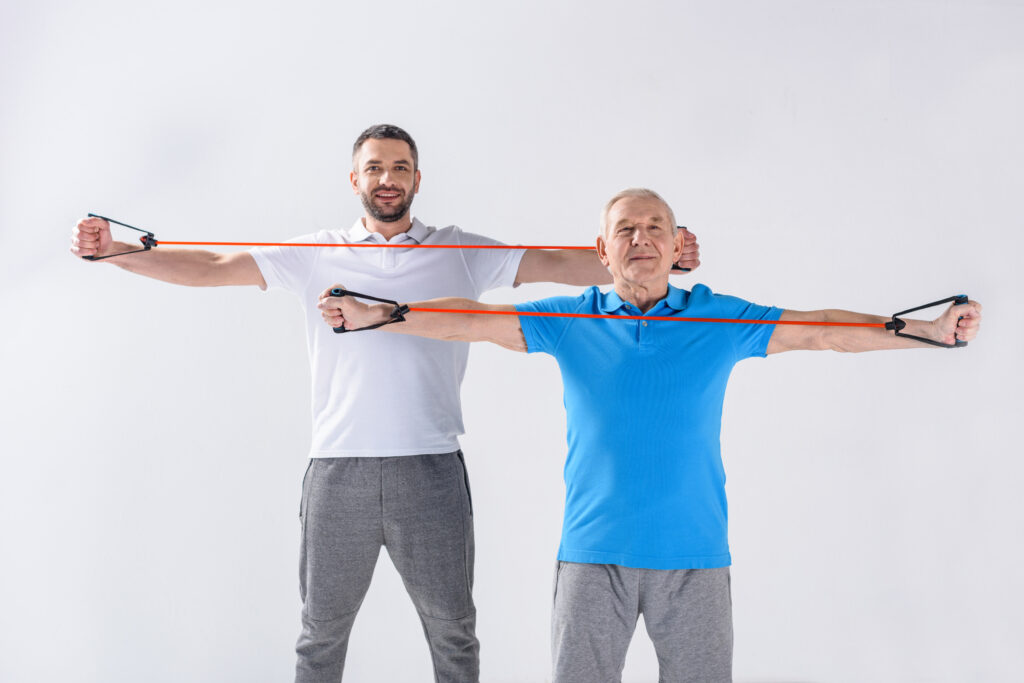If you find it difficult to exercise, then you aren’t alone. Exercises for caregivers and seniors can be daunting, but it doesn’t have to be. I grew up sedentary, under the wing of my mother— a warm, charismatic woman who unfortunately avoided physical activity and spent most of her daily life indoors, smoking. My father, on the other hand, was the active parent. Long before anyone else, he ran three miles faithfully every morning. Eventually I followed my father’s example, becoming what I call an “adult onset fitness lover,” and in the process lost thirty pounds that I have maintained ever since. Exercise itself didn’t make me lose weight, but it changed my perception of self, which did.
Here are 17 tips I’ve used over the years to motivate myself to be active.

1. Start By Noticing What You’re Already Doing Right
As a caregiver, you’re likely not an office worker sitting in front of a computer all day, so you’re already ahead of the game. You probably move and bend down a lot. If you work in a skilled nursing facility, you shower, feed and dress residents— physical activity to embrace.
2. Think Movement, Not Exercise.
“Exercise” is a modern concept referring to physical activity that is artificial, structured, timed, and often costly. Movement, on the other hand, is free and available anywhere and anytime.
3. Find A Form of Movement That Appeals to You
Can’t think of anything? Then remember what you liked to do when you were nine. Did you skip rope? (Using a jump rope is an excellent, portable form of cardio). Did you like to dance? Put on your favorite music and move furniture aside! (Whenever you exercise, music encourages rhythm and movement).
4. Live The Way Our Ancestors Did
Before modern conveniences and machines were invented, people stayed active all day long while doing routine tasks such as washing and hanging laundry, feeding the animals, raising crops, and so on. So unplug your machines. Forget the clothes dryer and the dishwasher. Sweep and mop, rake leaves, weed, and wash the car. These ordinary activities —the kind our grandparents grew up doing— do count, and if done throughout the day, can actually benefit you more than working out on a machine.

5. Go On A Car Diet
Exercises for caregivers can become part of your natural routine. As soon as you cut back on driving, you’ll automatically walk more and get fitter. Try parking your car in the driveway and not getting in it for a week. Can you walk to the bus or ride a bike to work? When you plan your daily activities, include walking as an integral part. Instead of driving to buy groceries, for example, can you walk part of the way if not the whole way?
Modern medical science says that walking is by far the most effective exercise we can do. “If there was a pill that could lower the risk of chronic disease like walking does, people would be clamoring for it,” says Dr. JoAnn Manson, Professor of Medicine at Harvard University. Walking reduces the risk of heart disease, cancer, osteoporosis and diabetes.
6. Aim For Three Different Types of Movement Per Day
This is easier than it sounds, because everything counts. You could, for example, walk, stretch, and sweep. Or walk, jump rope, and do a bit of gentle yoga like the cat-cow pose and a spinal twist.
7. Stand Up Every 20 Minutes
According to Dr James Levine, MD, of the Mayo Clinic, “sitting is the new smoking.” The very act of standing up regularly helps you get fit, improve circulation, reduce chronic disease, and lose weight.
8. Climb Stairs
Stair walking is an efficient form of physical activity that quickly increases heart rate and burns calories. If you work in an assisted living facility or a hospital, don’t use the elevator, use the stairs!
9. Go Outside
According to a 2004 study, twice as many people who exercise outdoors stick with their program consistently than those who work out indoors. If you can’t make yourself get out much, then having a dog will help.
10. Exercise In Short Spurts
If you don’t have much time, you can still exercise. Research shows that short bursts of exercise —like a ten-minute walk three times a day— may be more effective than one 30-minute walk. Most of us can find three sets of ten minutes to walk around the block!
11. Play With Your Kids
Exercises for caregivers can involve the whole family. Playing with a ball or frisbee or anything involving movement, preferably outside, models an active lifestyle and helps everyone stay fit.

12. Make Dates To Walk
Instead of meeting a friend and sitting down for coffee, suggest a walk with coffee.
13. When Interrupted, Start Again
Whenever your routine is disrupted, push yourself to do a minimum of exercise— only a few minutes if necessary. Your goal is to get past the disruption and back into the rhythm of moving. Practice what the Japanese call kaizen— small actions, no matter how “puny,” will help you get over the hump.
14. Don’t Worship The Gym
Researchers at the Mayo Clinic found that moving throughout the day is more powerful and effective than a half-hour workout at the gym, which may even be an obstacle to fitness. If you spend half an hour riding a stationary bike and most of the other 23½ hours of the day asleep, behind a steering wheel, and watching TV; that half-hour is not going to make much difference. Even worse, it may deceive you into thinking you’re doing enough for your body.
15. Invest In A Few Simple and Inexpensive Tools
Exercises for caregivers can include a yoga mat, a hula hoop, a jump rope, a resistance band, walking poles— these cost little but can encourage you to move. And if you like tracking your progress, a drugstore pedometer costs as little as $15.
16. Find An Accountability Buddy…
…a detached person you can check in with about your progress. A friend uses me as her accountability buddy to cut back on cigarettes. Each evening she sends me an email telling me how many she smoked. I don’t even reply. The simple knowledge that she has someone on her side helps her.
17. Be Kind To Yourself
Changing long-held habits takes time, patience and, above all, kindness. Try not to “should” yourself. Far from motivating us, lecturing and nagging lead to guilt— only a heartbeat away from shame, which is even worse.
Increasing your physical activity can be transformative! This is because movement is great not only for the body, but for the mind. It’s the body’s natural antidepressant. Just a ten-minute walk will help you feel calmer when your emotions are swirling, more focused when you’re distracted, and more energetic when you’re lethargic. Start moving, and you too will probably find it changes your life.

